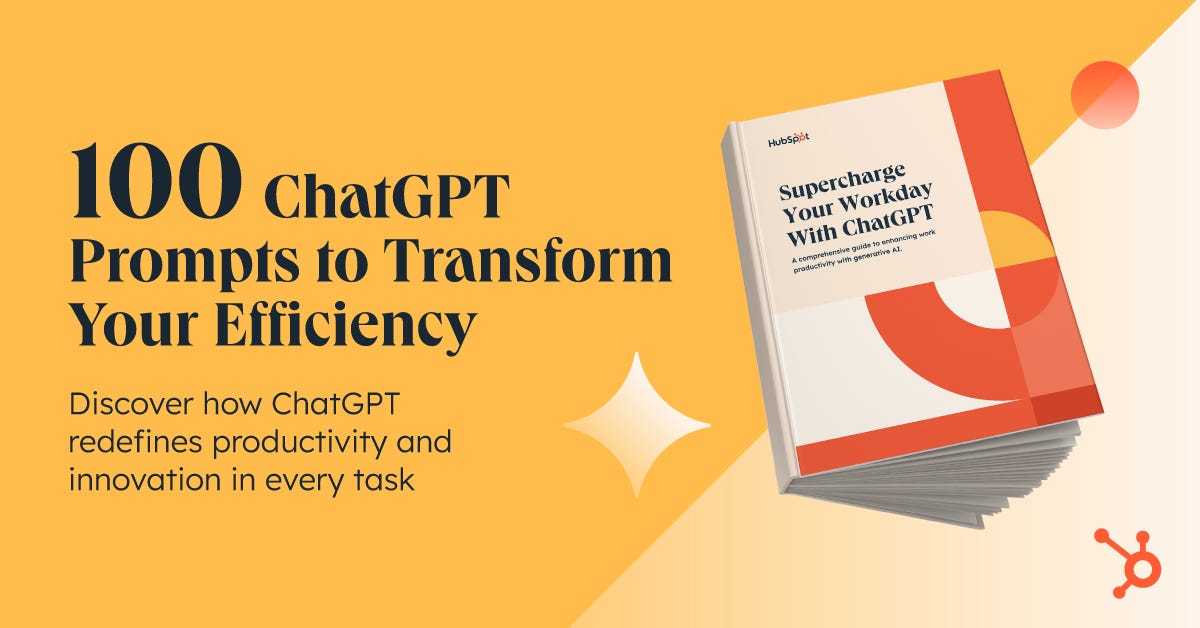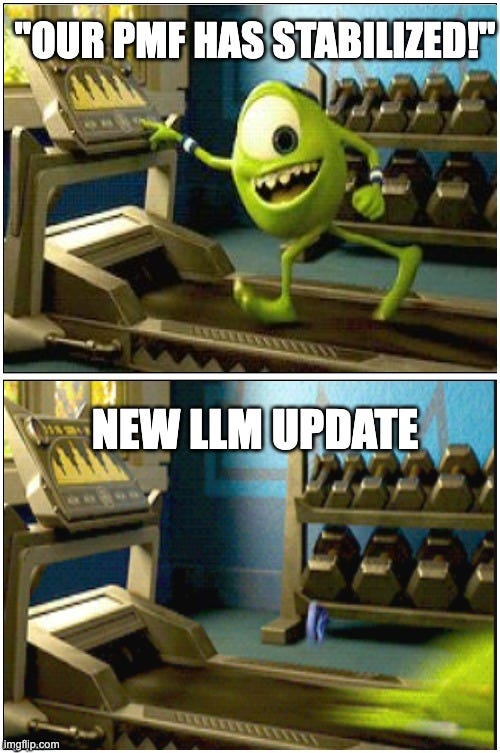The Product-Market Fit Treadmill: Why every AI company is sprinting just to stay in place
What a time to be alive…
Do you ever feel like you’re flat-out sprinting, just to stay in the same place? That’s the current reality of growth in AI companies, where the core foundations of your value proposition are up for grabs every week.
PMF used to be something companies would hit, maintain, and scale. You’d reach PMF, ride it for a few years, then invest in the next horizon when competitors or markets shifted.
That era is dead.
This post is brought to you by HubSpot’s new guide on using ChatGPT at work:
Supercharge your productivity with this free resource.
Industry-Specific Use Cases: 15+ real-world applications across various sectors
Productivity Guide: 21 best practices to 10x your efficiency with AI
Prompt Powerhouse: 100+ ready-to-use prompts for immediate implementation
Challenge Buster: Overcome common AI hurdles with expert strategies
Plus, deep dives on email composition, content creation, customer support, and data analysis.
AI companies aren’t marching through the 3 horizons, one at a time. They’re cycling through all of them every quarter. The “second horizon” isn’t about expansion anymore. It’s the price of keeping your first horizon alive.
PMF is no longer a one-time purchase. Now, it’s a subscription you have to keep renewing.
Which makes sense: The “Product” side of PMF is changing constantly, as the underlying LLM capabilities leapfrog each other every few months. And the “Market” side of PMF is shifting just as fast, as customers adjust their expectations through the arc of this major platform shift.
Product is shifting: John Cutler’s 3 Technological Cycles
Products evolving over time is not a new idea. In fact, John Cutler has a great framework that outlines the inevitable progression: every major tech shift goes through three waves.
Explore capabilities - What’s possible with this new technology? What can it do that was previously impossible?
Capture value - Now that it’s possible, what real value do I get? What problem is solved? What outcome is delivered?
Scale - Now that I get value, how does this system expand across my workflow, team, or life?
Right now in AI, we’re still deep in the capabilities phase. And capabilities keep expanding so fast that nobody can settle into the value phase. Every model release redefines what “good” is, which forces every company to sprint… just to get back to the starting line. Back onto the treadmill!
But if a new technology never transitions into the value phase, the cycle can’t progress. Customers won’t fully invest in the new tech until the value is proven, and the companies building the tech can’t progress in their growth if the demand isn’t there. You don’t have lasting PMF if the product isn’t solving problems or delivering positive outcomes.
The scale phase is basically where PMF becomes durable. It’s where growth teams can finally build systems, compounding channels, and predictable funnels instead of redoing them every few months.
Markets are shifting: Adjacent User Theory is breaking
But we’re not just trying to solve for one variable. Just like core product value is a moving target, your ideal users are shifting, too. And if you can’t lock in who your initial product matches, you can’t scale beyond them.
Bengaly’s Adjacent User Theory says your next growth wave comes from users one ring out from your current core. This works in normal tech cycles. But when your product keeps reinventing itself every time Anthropic or OpenAI drops a new model, adjacency rings don’t hold. You’re never expanding outward. You’re just redrawing the center. Adjacent users stop feeling adjacent because the “core user” changes every quarter.
This kills your ability to sequence growth. You end up stuck serving the same AI power users / early adopters to preserve PMF instead of expanding into new rings.
How the Treadmill Warps Marketing, Sales, and Growth
Working from the treadmill changes things for every go-to-market team.
In stable companies…
Marketing builds engines: SEO, brand, lifecycle, community.
Growth optimizes funnels and runs structured experiments.
Sales uses consistent value stories and predictable pitches.
Product improves incrementally while occasionally taking big bets.
Adjacent users and markets can be sequenced year over year.
Teams can invest in lasting systems because product definitions don’t change weekly.
In PMF-treadmill AI companies…
Marketing must relaunch messaging every quarter because the narrative goes stale instantly.
Growth can’t compound because the product keeps shifting under them.
Sales pitches age in dog years. By the time you finish the deck, the product and expectations change.
Product spends its time re-earning PMF rather than expanding it.
Adjacent-user targeting is impossible because “the core user” keeps morphing.
Teams can’t build durable systems because everything gets rewritten with each model cycle.
Everyone is sprinting. Nobody is compounding.
So, when does it end?
You’ll know the treadmill era is slowing down when a few things shift:
On the product side…
LLM progress becomes incremental instead of exponential.
AI-native UX patterns stabilize and stop reinventing themselves every quarter.
Model release cycles become longer and less disruptive.
On the market side…
Early adopters become happy with the existing value.
Companies shift from “capability shock” to “ROI proof.”
Customers begin caring more about outcomes than features.
These are the signals that stable Product-Market Fit has actually become possible again. That’s when we move into the value cycle. Growth motions will start to stick again. Adjacent users will be mappable. And then scale will become a normal, boring exercise. That’s where the real enterprise value gets created.
My guess is we have a few more years of volatility - not months - because the foundational models still have big leaps ahead.
Until then, make the most of it. With everything AI is breaking, there’s also opportunity. You can beat incumbents because nobody has a moat. Early adopters are particularly enthusiastic and will give you organic distribution. Shipping fast is what matters most, so you can strip away a lot of the distractions. And of course these are some of the fastest-moving waters in history. This wave of change will create huge growth for companies and careers.
So pace yourself. We all have to keep running, but the treadmill won’t be slowing down any time soon.
Edited by Jonathan Yagel.



